A Low-Profile Dielectric Resonator Filter with Wide Stopband for High Integration on PCB
Abstract
:1. Introduction
2. Proposed Low-Profile Dielectric Resonator Filter with Wide Stopband
2.1. Methodology and DR Filter Design
2.2. Parametric Study and Performance Analysis
2.3. Design Procedure
- (i)
- Obtain the dimensions of the high integrated dielectric resonators according to the desired center frequency from the resonant mode frequency variation.
- (ii)
- Achieve l0 according to the coupling matrix and impedance matching parametric study in Figure 6a.
- (iii)
- Obtain gap according to the coupling matrix and bandwidth parametric study in Figure 6b.
- (iv)
- Optimize the performance and obtain the final dimensions in CST.
3. Results
4. Conclusions
Author Contributions
Funding
Data Availability Statement
Conflicts of Interest
References
- Huang, F.X.; Fouladi, S.; Mansour, R.R. High-tunable dielectric resonator filters using MEMS technology. IEEE Trans. Microw. Theory Tech. 2011, 59, 3401–3409. [Google Scholar] [CrossRef]
- Höft, M. Y-Shape Dielectric dual-mode resonator. IEEE Trans. Microw. Theory Tech. 2008, 56, 3066–3071. [Google Scholar] [CrossRef]
- Zhou, L.H.; Chen, J.X.; Xue, Q. Design of compact coaxial-like bandpass filters using dielectric-loaded strip resonator. IEEE Trans. Microw. Theory Tech. 2018, 8, 456–464. [Google Scholar] [CrossRef]
- Memarian, M.; Mansour, R.R. Quad-mode and dual-mode dielectric resonator filter. IEEE Trans. Microw. Theory Tech. 2009, 57, 3418–3426. [Google Scholar] [CrossRef]
- Zhu, Y.Y.; Li, Y.L.; Chen, J.X. A novel dielectric strip resonator filter. IEEE Microw. Wirel. Compon. Lett. 2018, 28, 591–593. [Google Scholar] [CrossRef]
- Meher, P.R.; Behera, B.R.; Mishra, S.K.; Althuwayb, A.A. A chronological review of circularly polarized dielectric resonator antenna: Design and developments. Int. J. RF Microw. Comput. Aided Eng. 2021, 31, e22589. [Google Scholar] [CrossRef]
- Meher, P.R.; Behera, B.R.; Mishra, S.K. Design and its state-of-the-art of different shaped dielectric resonator antennas at millimeter-wave frequency band. Int. J. RF Microw. Comput. Aided Eng. 2020, 30, e22221. [Google Scholar] [CrossRef]
- Zhu, Y.; Dong, Y. A novel compact wide-stopband filter with hybrid structure by combining SIW and microstrip technologies. IEEE Microw. Wirel. Compon. Lett. 2021, 31, 841–844. [Google Scholar] [CrossRef]
- Tang, C.-W.; Tseng, C.-T.; Chiu, S.-H.; Wu, P.H. Design of wide passband/stopband microstrip bandpass filters with the stepped coupled line. IEEE Trans. Microw. Theory Tech. 2013, 61, 1095–1103. [Google Scholar] [CrossRef]
- Azad, A.R.; Mohan, A. Substrate integrated waveguide dual-band and wide-stopband bandpass filters. IEEE Microw. Wirel. Compon. Lett. 2018, 28, 660–662. [Google Scholar] [CrossRef]
- Yang, M.; Wang, H.; Yang, T.; Hu, B.; Li, H.; Zhou, Y.; Li, T. Design of wide stopband for waveguide low-pass filter based on circuit and field combined analysis. IEEE Microw. Wirel. Compon. Lett. 2021, 31, 1199–1202. [Google Scholar] [CrossRef]
- Tang, C.W.; Hsu, Y.K. A microstrip bandpass filter with ultrawide stopband. IEEE Trans. Microw. Theory Tech. 2008, 56, 1468–1472. [Google Scholar] [CrossRef]
- Chen, J.X.; Zhan, Y.; Qin, W.; Bao, Z.H. Analysis and design of balanced dielectric resonator bandpass filters. IEEE Trans. Microw. Theory Tech. 2016, 64, 1476–1483. [Google Scholar] [CrossRef]
- Chen, J.X.; Zhan, Y.; Qin, W.; Bao, Z.H. Novel narrow-band balanced bandpass filter using rectangular dielectric resonator. IEEE Microw. Wirel. Compon. Lett. 2015, 25, 289–291. [Google Scholar] [CrossRef]
- Hwang, H.Y.; Park, N.S.; Cho, Y.H. The design of bandpass filters made of both dielectric and coaxial resonators. IEEE MTT-S Int. Microw. Symp. Digest. 1997, 2, 805–808. [Google Scholar]
- Zhang, Y.; Chen, J.X.; Qin, W.; Li, J.; Bao, Z.H. Spurious-free differential bandpass filter using hybrid dielectric and coaxial resonators. IEEE Microw. Wirel. Compon. Lett. 2016, 26, 574–576. [Google Scholar] [CrossRef]
- Boe, P.; Mick, D.; Kamrath, F.; Hoft, M. Hybrid inline TE/TM mode dielectric resonator filters with wide spurious free range and controllable transmission zeros. Proceeding of the 2020 50th European Microwave Conference (EuMC), Utrecht, The Netherlands, 12–14 January 2021; IEEE: Piscataway, NJ, USA, 2021; Volume 55, pp. 2168–2175. [Google Scholar]
- Snyder, R.V. Dielectric resonator filters with wide stopbands. IEEE Trans. Microw. Theory Tech. 1992, 40, 555–558. [Google Scholar] [CrossRef]
- Sun, X.G. Ring-type dielectric resonator cavity filters with wide spurious free region. IEEE Microw. Dep. Transcend Commun. Co. 2007, 66, 2105–2108. [Google Scholar]
- Zhang, R.; Mansour, R.R. Low-cost dielectric-resonator filters with improved spurious performance. IEEE Trans. Microw. Theory Tech. 2007, 55, 2168–2175. [Google Scholar] [CrossRef]
- Chu, Q.-X.; Ouyang, X.; Wang, H.; Chen, F.-C. TE01δ–mode dielectric-resonator filters witch controllable transmission zeros. IEEE Trans. Microw. Theory Tech. 2013, 61, 1086–1094. [Google Scholar] [CrossRef]
- Hong, J.S.; Lancaster, M.J. Microstrip Filters for RF/Microwave Applications; Wiley: New York, NY, USA, 2001; Chapters 8–10. [Google Scholar]
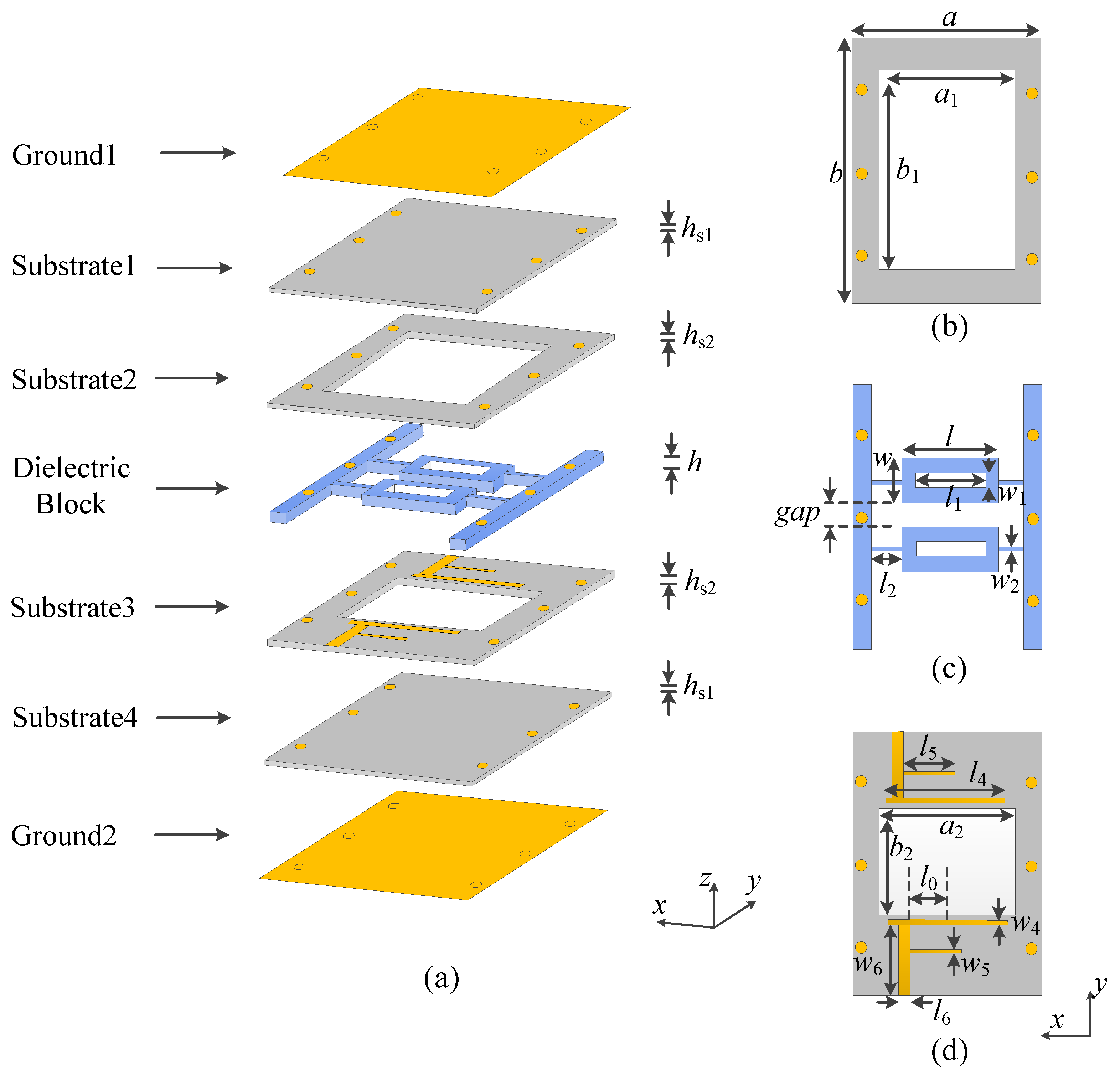
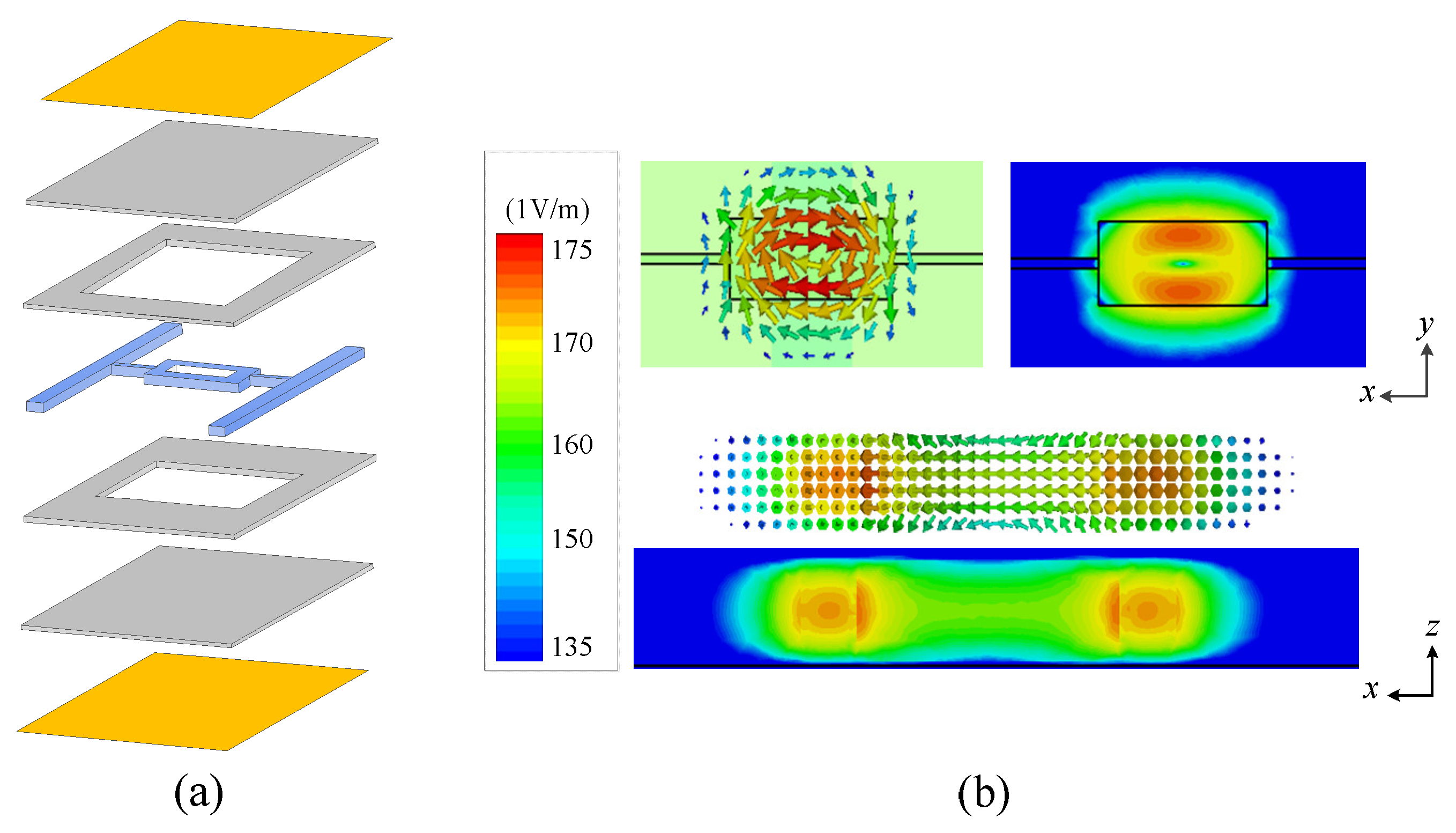

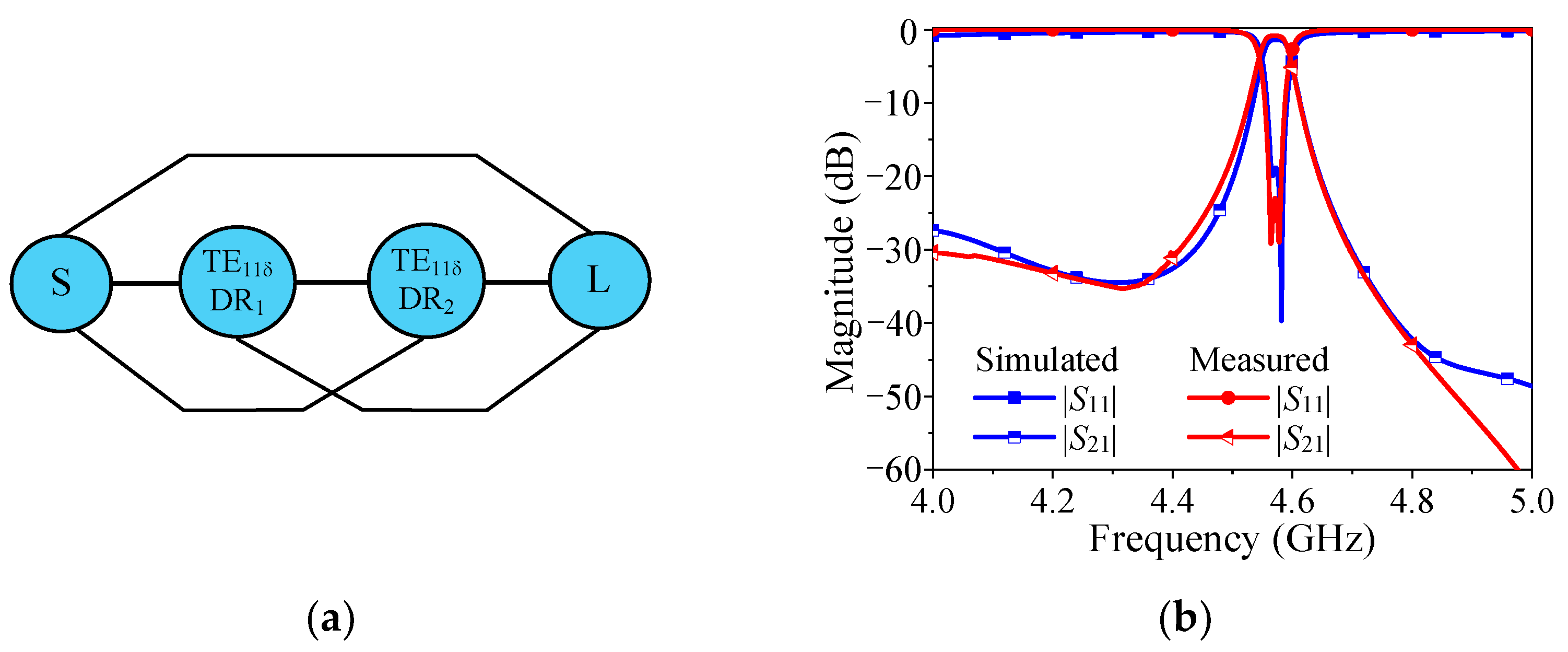
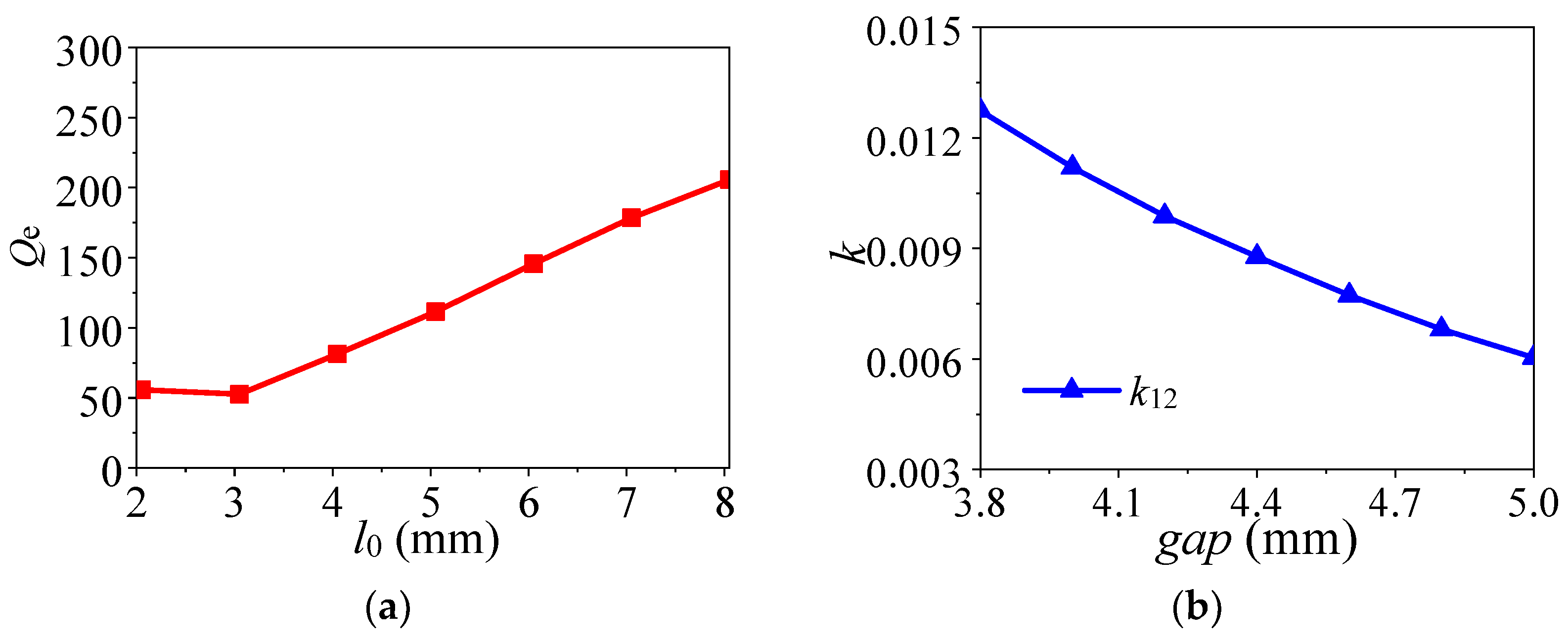

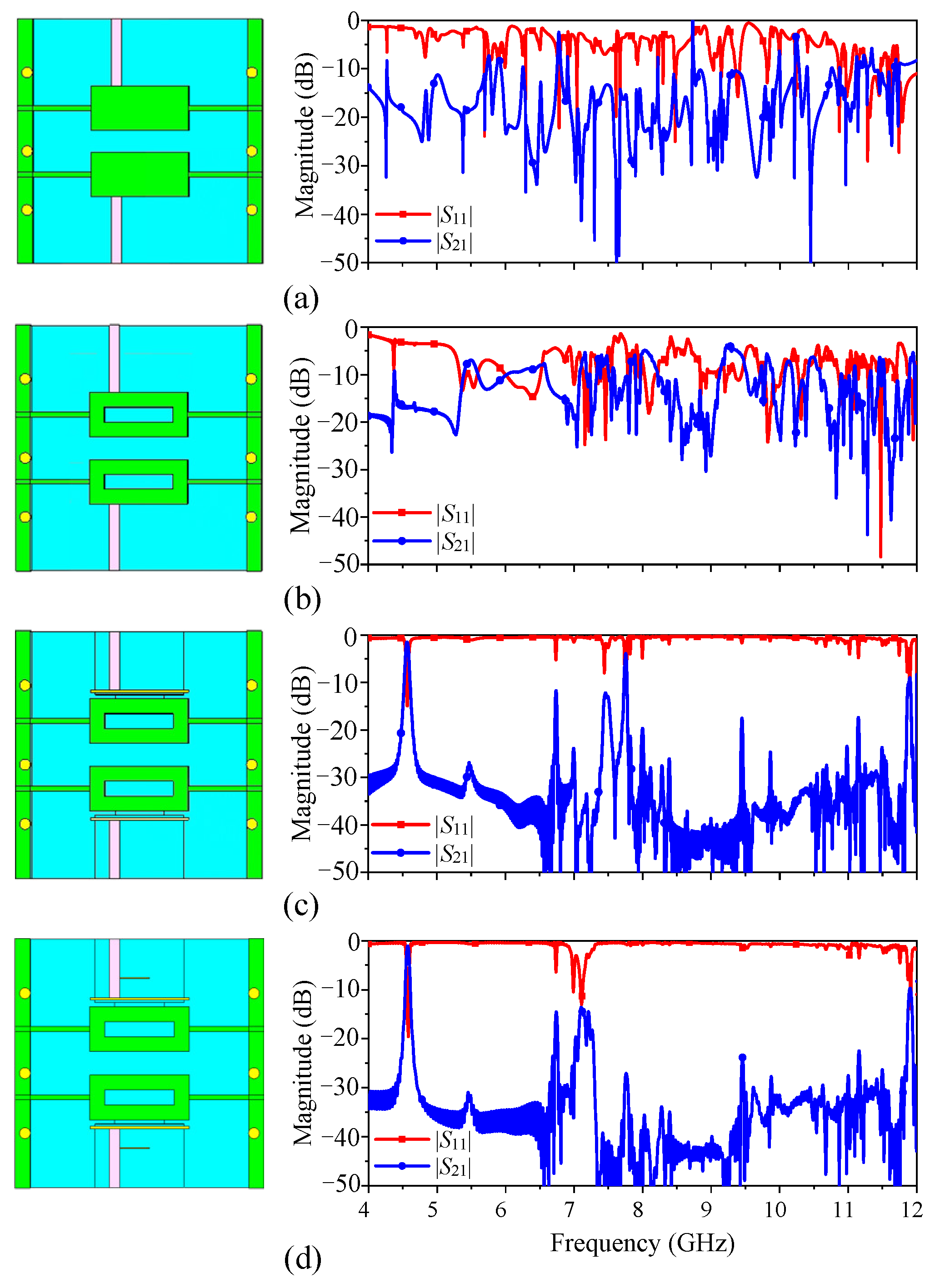
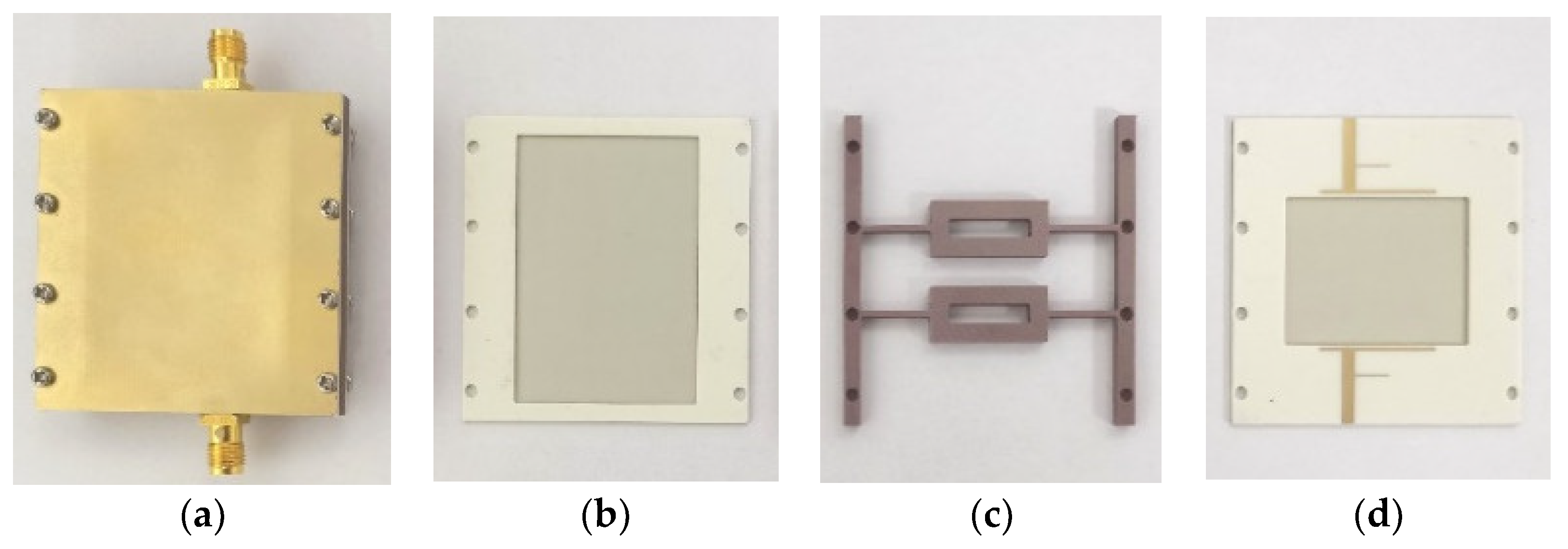

| Ref. No. | f0 (GHz) | 3-dB FBW (%) | Insertion Loss (dB) | Qu | Profile (λg) | Wide Stopband | Easy to Integrate |
|---|---|---|---|---|---|---|---|
| [11] | 1.82 | 0.32 | 0.55 | N.A | 1.12 | 1.22f0 | No |
| [12] | 3.967 | 5 | 1.28 | 1077 | 0.985 | 1.05f0 | No |
| [13] | 1.755 | N.A | 0.5 | 5000 | 1.26 | 2.5f0 | No |
| [14] | 1.75 | 1.34 | 0.8 | N.A | 1.19 | 2.12f0 | No |
| [15] | 2.014 | 1.19M | N.A | 2550 | 2.78 | >15 dB up to 2.135f0 | No |
| [16] | 5.9 | 0.35 | 1.3 | 5500 | N.A | 1.7f0 | No |
| [17] | 5.15 | 55 | 0.32 | N.A. | N.A | 1.45f0 | No |
| [18] | 4.0 | 40 | 0.25 | 5000 | 0.704 | 1.15f0 | No |
| [19] | 1.86 | 20 | 0.5 | N.A | 1.57 | 1.24f0 | No |
| This work | 4.57 | 0.99 | 1.29 | 1315 | 0.77 | >13.6 dB up to 2.61f0 | Yes |
Disclaimer/Publisher’s Note: The statements, opinions and data contained in all publications are solely those of the individual author(s) and contributor(s) and not of MDPI and/or the editor(s). MDPI and/or the editor(s) disclaim responsibility for any injury to people or property resulting from any ideas, methods, instructions or products referred to in the content. |
© 2023 by the authors. Licensee MDPI, Basel, Switzerland. This article is an open access article distributed under the terms and conditions of the Creative Commons Attribution (CC BY) license (https://creativecommons.org/licenses/by/4.0/).
Share and Cite
Lin, S.; Wang, M.; Xu, K.; Zhang, L. A Low-Profile Dielectric Resonator Filter with Wide Stopband for High Integration on PCB. Micromachines 2023, 14, 1803. https://doi.org/10.3390/mi14091803
Lin S, Wang M, Xu K, Zhang L. A Low-Profile Dielectric Resonator Filter with Wide Stopband for High Integration on PCB. Micromachines. 2023; 14(9):1803. https://doi.org/10.3390/mi14091803
Chicago/Turabian StyleLin, Shixian, Mengdan Wang, Kai Xu, and Lingyan Zhang. 2023. "A Low-Profile Dielectric Resonator Filter with Wide Stopband for High Integration on PCB" Micromachines 14, no. 9: 1803. https://doi.org/10.3390/mi14091803
APA StyleLin, S., Wang, M., Xu, K., & Zhang, L. (2023). A Low-Profile Dielectric Resonator Filter with Wide Stopband for High Integration on PCB. Micromachines, 14(9), 1803. https://doi.org/10.3390/mi14091803





